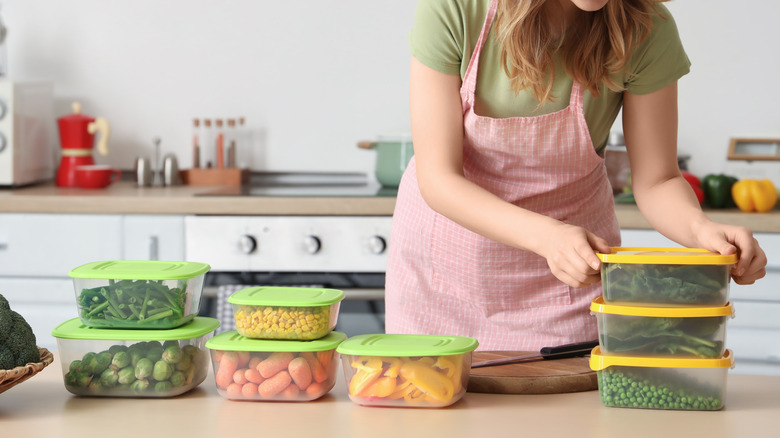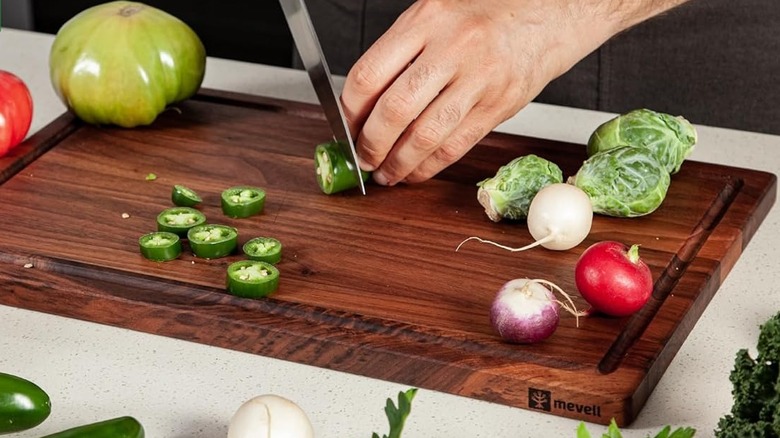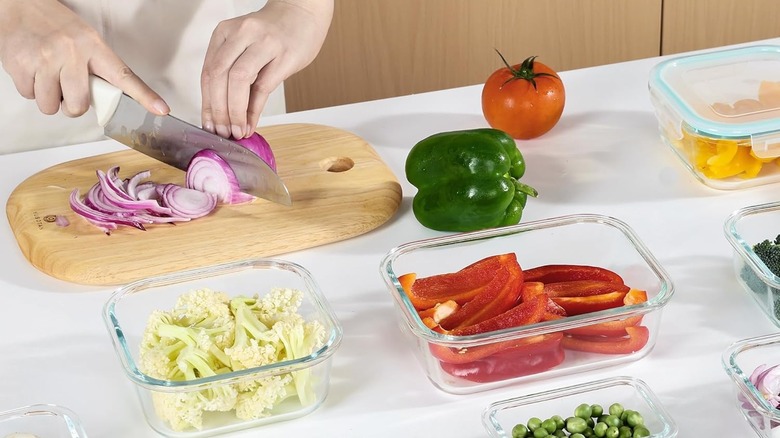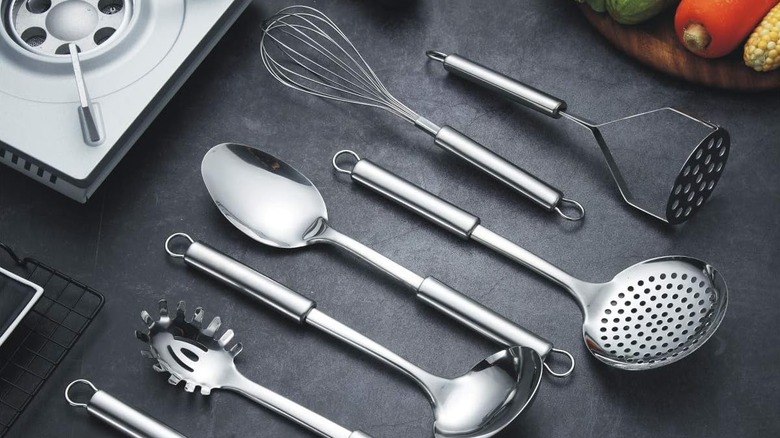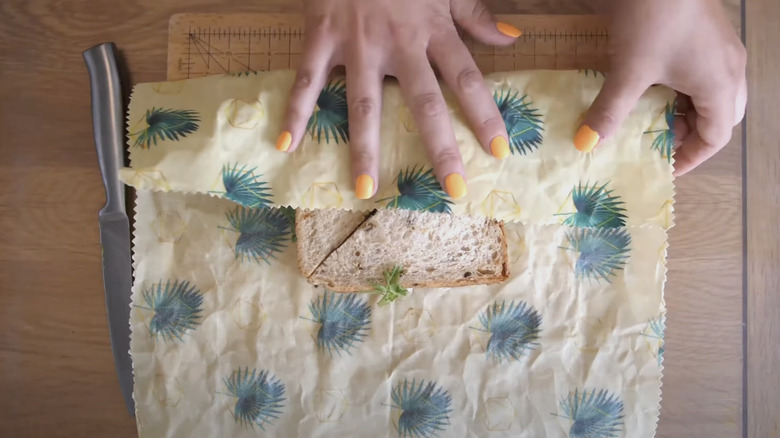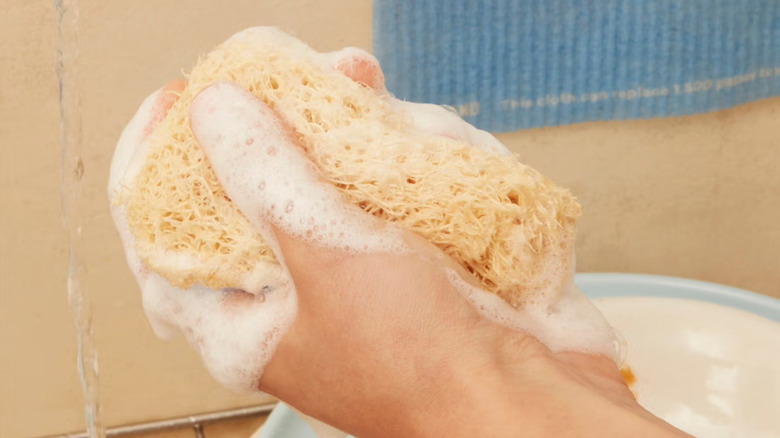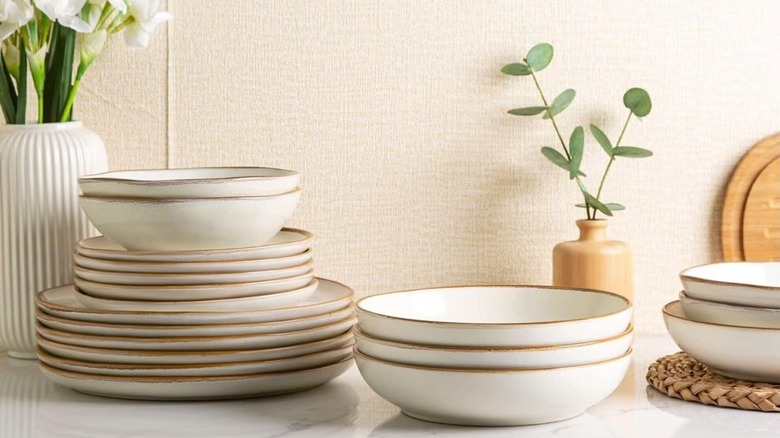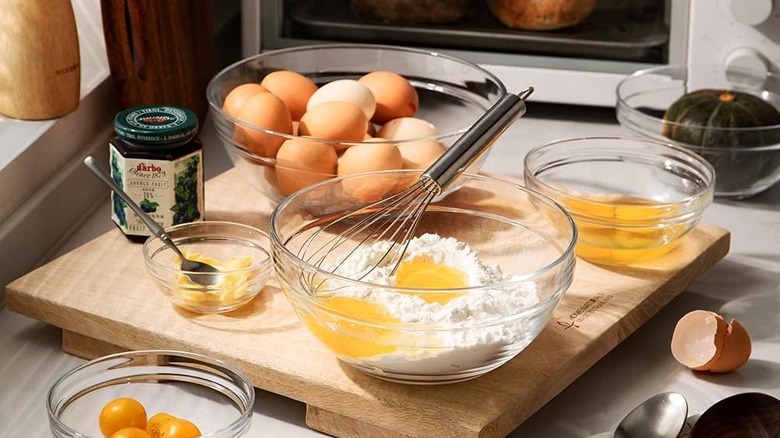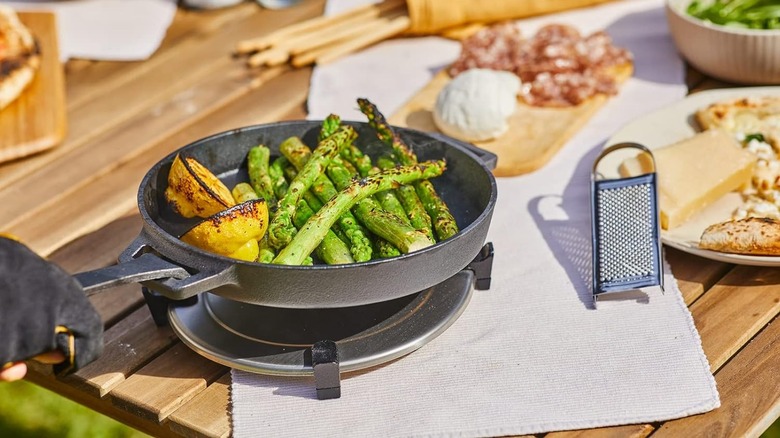It's Time To Ditch These Plastic Kitchen Items For Safer Alternatives
We may receive a commission on purchases made from links.
The overconsumption of plastics has been a growing concern throughout the United States and the rest of the world for years. In 2024, there was a record number of Google searches for "microplastic" after they were discovered inside human bodies. Motivated by this knowledge, many households are looking for ways to reduce plastic use in their homes. Thousands of cookware, dishware, utensils, and other cooking products are made with plastic materials and coatings. Fortunately, plastic isn't our only option — plenty of alternative materials and products are out there.
Below are several kitchen items you should get rid of to reduce common toxins in your home. Replacing plastic-based products with safer, eco-friendly alternatives could benefit your health, support smaller businesses, and lessen your environmental impact. Although the FDA says plastic dishes are safe to cook with, The American Journal of Medicine released an article questioning whether we have enough evidence to back this. Many studies on leached chemicals come from the plastic manufacturers themselves, which creates a conflict of interest, according to the authors. There are multiple types of plastics, each one with its accompanying chemicals that you should be aware of before continuing to use them. Learn more below about eight typical plastic products that you can easily trade out, so you can do your part in reducing the widespread demand for polymer materials and minimize potential microplastics in your kitchen.
Swap poly plastic cutting boards for bamboo or hardwood
Start the process of eliminating kitchen plasticware by replacing plastic cutting boards with a safer alternative. Dr. Hershey, a professional toxicologist, told The Steel Board, "With each slice and dice, you're creating microscopic plastic shavings that mix into your food." This claim is backed by an American Chemical Society study that investigated how much plastic is shed when using poly plastic-based cutting boards. Specifically, polyethylene boards released the most plastic pieces during the trials. In real-life situations, these particles contaminate the food being prepared. When people ingest them, there are many potential health side effects that may impact digestive, respiratory, reproductive, and immune systems.
Considering the looming health risks of plastic, it's probably time to replace kitchen cutting boards with safer hardwood or bamboo alternatives. Hardwood has antimicrobial properties that discourage bacteria growth. More specifically, end-grain boards, like cherry, maple, and walnut, are sturdy and don't dull knives as quickly as glass, metal, and stone options, which is why we prefer wood cutting boards to these other non-plastic options. Plastic cutting boards are often the most budget-friendly buy, but you can find relatively affordable wood ones as well. For instance, something like the Royal Craft Wood Bamboo Cutting Board Set, even though it costs around $12 per board, will likely last much longer than a plastic alternative. What's more, you can easily bring an old wooden cutting board back to life with a thorough cleaning or by sanding it down — something you can't do with plastic.
Switch plastic containers for glass food storage sets
Plastic storage containers are commonplace in most modern kitchens. Despite their popularity, there are multiple reasons to choose glass alternatives over plastic. Budget-friendly and mass-produced plastic storage containers are sometimes made with BPA. The U.S. Food and Drug Administration (FDA) claims BPA is safe at low levels. Nonetheless, plastic containers break down with repetitive use, releasing more chemicals as they're exposed to dishwashers, microwaves, and steaming foods. It may be "safe" in small amounts, but BPA is linked to health issues, especially in babies and children. On the other hand, you may have seen plastic containers labeled as "HPDE" and "BPA-free", but these items are not labeled food-grade for a reason. They contain PFAS (perfluoroalkyl and polyfluoroalkyl substances), another type of chemical that has been linked to various negative health effects ranging from fertility to immune system issues.
Fortunately, it's becoming easier to replace HPDE and BPA plastics with glass food storage containers. Glass is non-porous and inert, meaning it doesn't have any chemicals that potentially seep into food. Try to stay away from plastic lids as an extra precaution. Although, lids should pose minimal risks as long as they aren't exposed to heat, as well as thrown away when they start looking worn out. Glass "tupperware" containers used to be a specialty product, but nowadays you can easily find them on Amazon. We particularly like the Verel Glass Food Storage Containers With Bamboo Lids.
Replace plastic utensils with stainless steel or wooden items
The internet has recently become obsessed with the health consequences of black plastic kitchen items, and for good reason. One of the reasons why you should think twice about choosing black plastic kitchen utensils is that these items contain BFRs, which are flame-retardant chemicals that reduce fire risk, but poorly affect health. When these plastic items are exposed to heat, such as when you're cooking or eating hot foods, they release chemicals that have been linked to issues with immune and reproduction systems. At the moment, these risks are what most warnings are focusing on, but we'd venture a guess that plastic cooking utensils also give off microplastics over time (one only has to picture the ragged edge on an old plastic spatula for this to sound plausible).
BFR research is still underway, but in the meantime, swapping out plastic utensils for stainless steel or wood is probably a good best. Stainless steel is non-reactive, doesn't release harmful fumes, and doesn't leach additional chemicals or flavors into food. Wooden utensils aren't as ideal as stainless steel, as they can crack and are more difficult to clean, but are still a good alternative for those who don't want to scratch their pans and plates. Certain types of wood, like oak, pine, spruce, and other previously mentioned species, are also known for having antibacterial properties, which is a great benefit when working with food.
Trade plastic wrap for natural beeswax wrap
Plastic wrap has been around for nearly a century, but regardless of its age, it's not the best choice for preserving food products. Plastic wrap is made of phthalate-free polyvinyl chloride (PVC) since phthalates were discovered to affect child behavior. However, PVC still contains DEHA, which, unsurprisingly, has also been linked to human health issues. DEHA particles get into food the same way most plastic products do. When plastic wrap touches hot food, especially ingredients high in fat, microplastics can transfer.
Fortunately, it is possible to avoid the potential risks of micro PVC particles by switching to an eco-friendly and sustainable alternative. You can DIY beeswax food storage wraps at home or purchase them ready-made. If you choose to buy them, look for options made of natural materials, such as cotton, coated in beeswax and plant oils like coconut or jojoba oil. It helps to do some research and find well-reviewed brands or ones you can test in person before buying. If you choose wisely, the wraps will be reusable, have natural antimicrobial properties (thanks to the beeswax), and effectively preserve food. Bee's Wrap Reusable Beeswax Food Wraps are a popular choice since they're affordable and easy to clean.
Swap out foam sponges for plant-based or fabric scrubbers instead
Plastic products have probably even dominated parts of your kitchen that you may not expect. Popular foam sponge brands, like Scotch-Brite, Scrub Daddy, and Mr. Clean, all contain melamine. Melamine foam is great for scouring dishes, but it sheds millions of microplastic fibers as it wears out. These microplastics end up on clean dishes and utensils, which people then eat off of. The tiny pieces also go whirling down sink drains, contaminating sewer systems and the environment, meaning these microplastics are entering the ecosystem as well as lurking in your kitchen. Besides being a source of microplastics, melamine is also classified as a possible carcinogen.
There are a few eco-friendly kitchen sponge alternatives to use instead. They're slightly more expensive, but without the potential health risks of melamine. Amazon carries reusable and biodegradable Swedish Dishcloths and Blueland Plastic-Free Plant-Based Scrub Sponges, which are both compostable, making them fully eco-friendly even after they're used up. Greenth Pro Bamboo Palm Pot Natural Scrub Brushes are also plastic-free, if you'd rather use a scrub brush over a dishcloth or sponge.
Exchange plastic dishware for ceramic, porcelain, or compostable alternatives
Cheap, plastic dinnerware sets seem ideal at a glance. However, these dishes aren't always microwave-safe, especially if they have a BPA lining or coating. Polypropylene bowls and plates usually don't contain BPA, but may contain phthalates. As previously discussed, these chemicals have their own set of potential health issues that closely mirror BPA's, such as reproductive and respiratory issues.
Avoid the dangers of plastic dinnerware altogether by investing in nontoxic ceramic or porcelain alternatives. But, don't go out and buy any stoneware dinnerware set you can find. Many vintage ceramic and porcelain dishes have a shiny glaze that contains lead, so you must make a conscientious decision. Look for BPA, cadmium, and phthalate-free stoneware to avoid the same dangers commonly found in many plastic blends. Play it safe by choosing USA-made and regulated products certified to be lead-free, and lean towards clear and white-colored ceramic and porcelain dinnerware sets. Colorants used in these materials greatly vary — some are completely safe, while others are potentially toxic. Toxicity risks can arise when colorants are combined with metal oxides, and to avoid these risks altogether, it can be safer to choose non-colored dishes.
Switch out plastic mixing bowls with microwave-safe ceramic or glass
Using plastic mixing bowls to prepare cold and room temperature ingredients usually isn't a problem. In fact, the biggest concern is often that it's hard to scrape fatty and sticky foods from the sides. Many plastic mixing bowls are made with polypropylene plastic, meaning they're BPA-free, but do contain phthalates. Therefore, they could be toxic when damaged or exposed to heat. You may notice that many mixing bowls are dishwasher-safe, but don't assume this also means microwave-safe. Being dishwasher safe means it won't get warped or damaged by high heat, but this rating reveals nothing about chemicals leaching when microwaved.
Avoid worrying about plastic phthalates by using kiln-baked clay or ceramic mixing bowls instead. Follow the previous advice in making sure you buy a lead and glaze-free stoneware bowl, and it should be safe to microwave and stir heated ingredients. The same rules apply to glass bowls, as long as they don't have painted or metallic embellishments. Stainless steel mixing bowls are also a potential option without chemical risk; however, they cannot be microwaved.
Toss non-stick cookware for cast iron or stainless steel
Non-stick cookware doesn't have "plastic" in its name, but has a poly-blend coating known as PTFE or Teflon. This blend, like HDPE-labeled plastics, contains PFAS chemicals. When exposed to stovetop temperatures above 500 degrees Fahrenheit, or when scratched by metal utensils, microplastic particles get released into the air. This makes it an unwise choice for cooking, since both electric and gas stoves can exceed 500 degrees. The most obvious types of non-stick cookware are frying pans and baking sheets — but small appliances like air fryers can also feature non-stick coatings.
Save yourself the anxiety of dealing with non-stick cookware, and use a stainless steel or uncoated cast iron pan instead. When using stainless steel, don't try to save money by using a lower-quality option. Low-grade stainless steel can leach metals like chromium and nickel into acidic dishes. Make sure you pick something food-grade. The best you can get is a 316 or 18/10 grade, such as All-Clad's D5 Stainless-Steel Saucepan or All-Clad's D5 Stainless-Steel Deep Skillet Set. With cast iron cookware trace amounts of iron can get infused into the food. However, this usually isn't a cause for concern (it can even be a beneficial source of iron), and the only time cast iron truly poses a health risk is if it has a non-stick coating. When shopping for appliances like air fryers, prioritize high-quality models with glass or stainless steel cooking surfaces and compartments.
